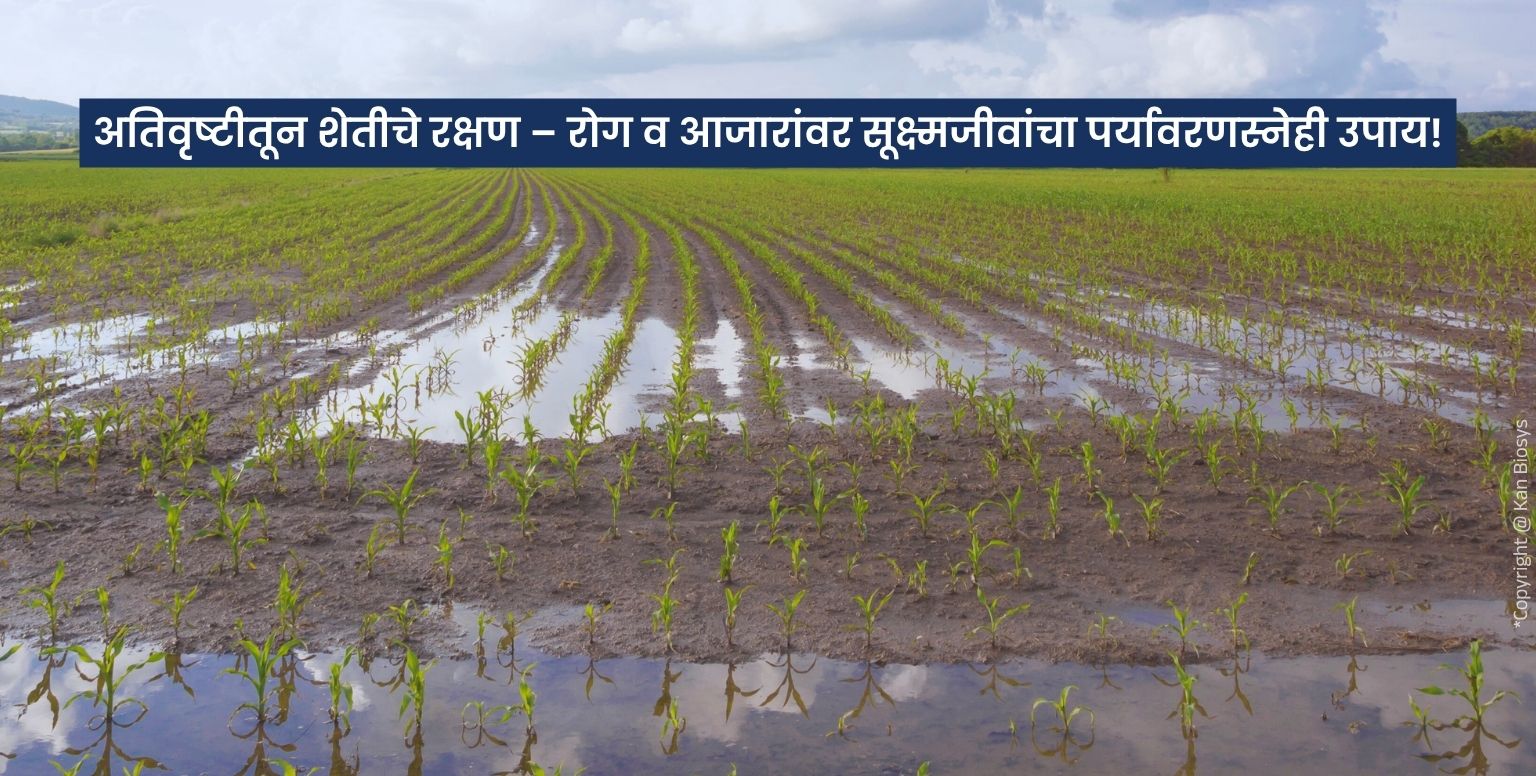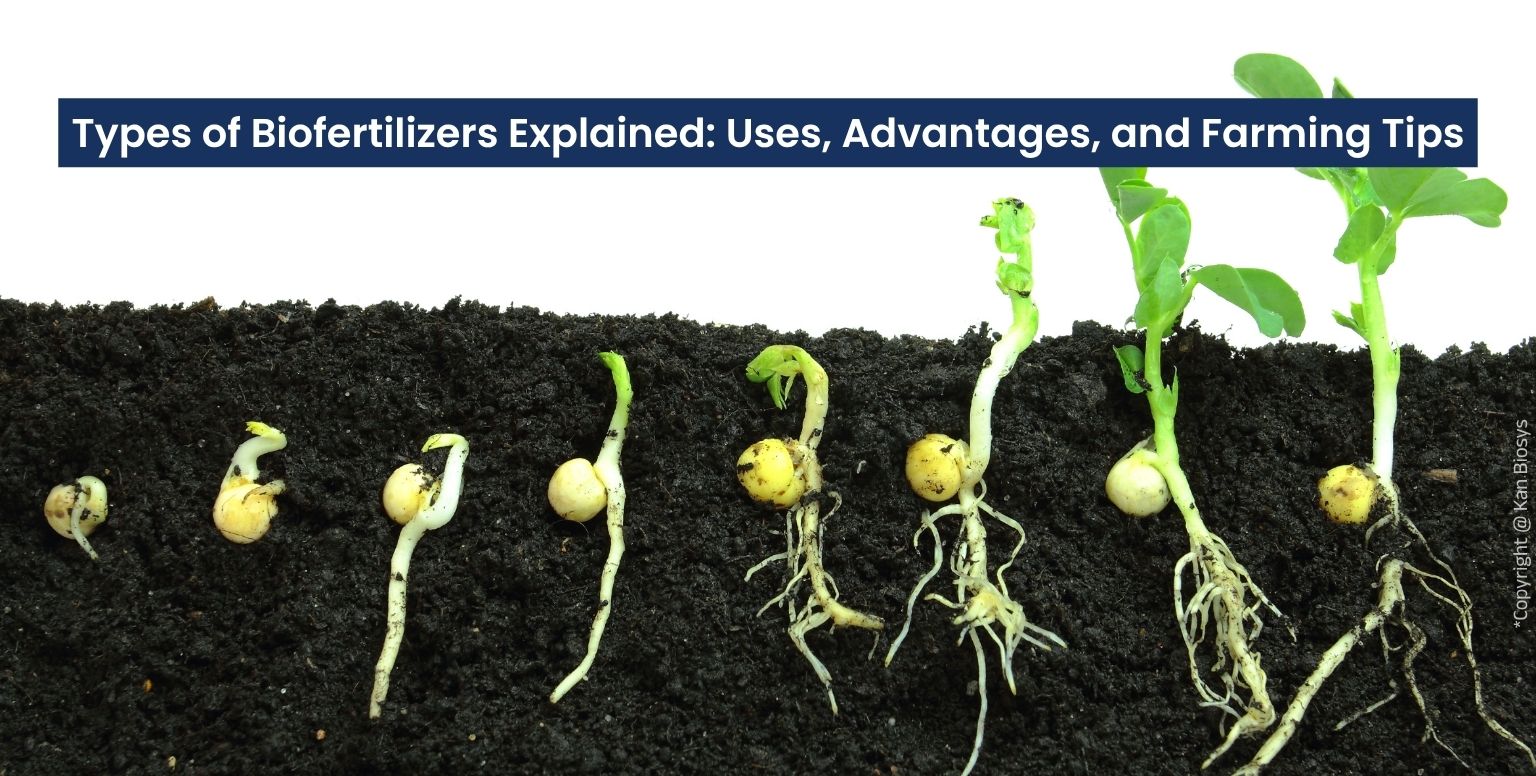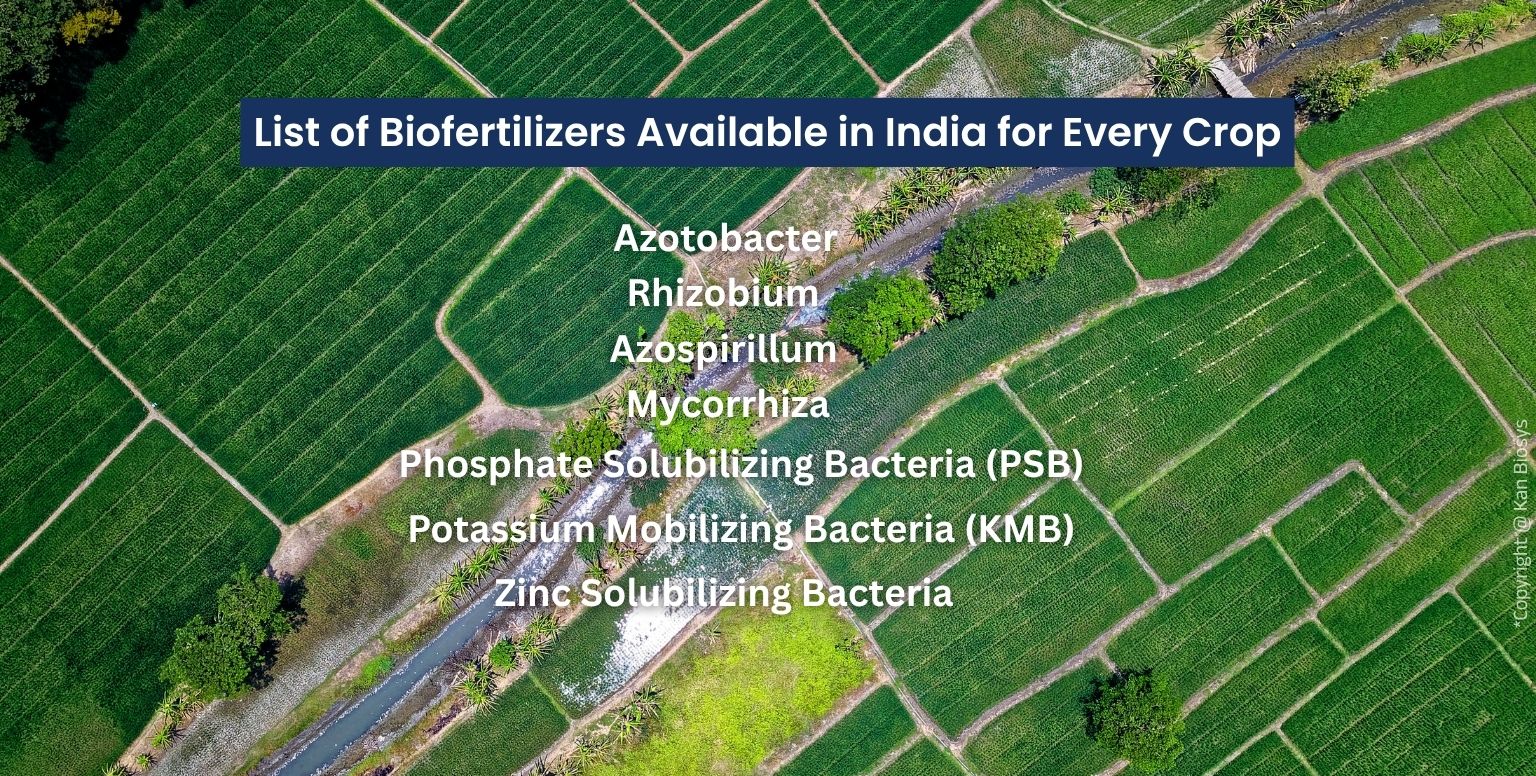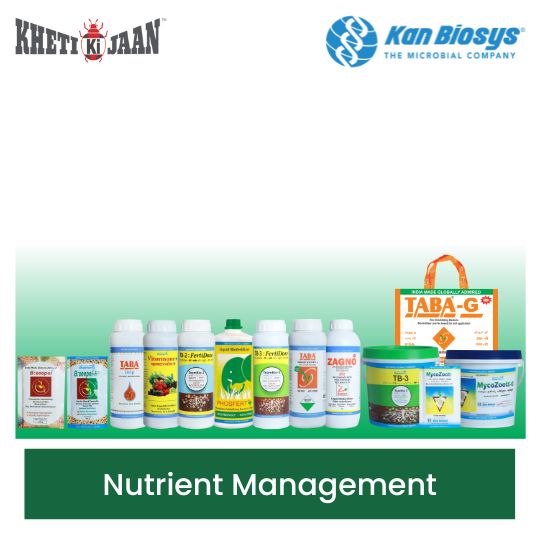Types of Biofertilizers Explained: Uses, Advantages, and Farming Tips
Types of Biofertilizers Explained: Uses, Advantages, and Farming Tips
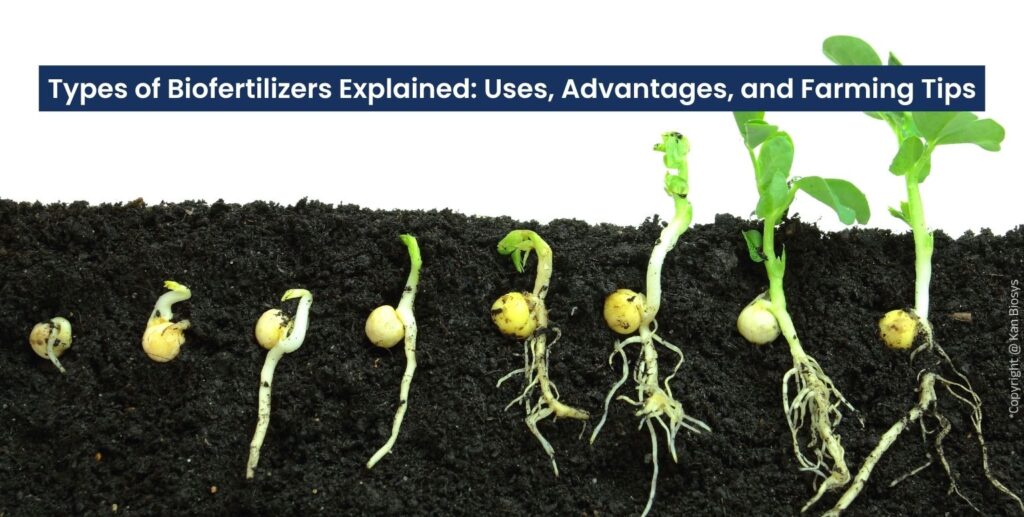
“With so many biofertilizers in the market, how do you choose the right one?” — It’s a question many progressive farmers are asking today. As sustainable and organic farming practices gain traction, understanding the types of biofertilizers available has become crucial for maximizing yield and maintaining soil health.
Biofertilizers aren’t a one-size-fits-all solution. Each type is made up of specific beneficial microorganisms that perform unique roles — some fix nitrogen, others solubilize phosphate or mobilize potassium. Their effectiveness also depends on soil conditions, crop type, and nutrient requirements, making the right selection is key to achieving the best results.
In this guide, we’ll simplify the complexity. You’ll discover the different types of biofertilizers, how they work, their advantages in modern farming, and practical tips to help you choose the right one for your crops. Whether you’re growing cereals, pulses, or horticultural produce, this breakdown will help you make informed decisions for healthier soil and higher productivity.
How Are Biofertilizers Classified?
Biofertilizers come in many forms — and understanding their classification helps farmers select the most effective one for their specific crops and soil needs. Generally, the types of biofertilizer are categorized based on four main criteria: the type of microorganism they contain, the nutrient they help supply, how they interact with plants, and the form in which they’re applied. Let’s break these down.
By Microbial Type
Different microorganisms play different roles in promoting plant growth. Based on the organism used, biofertilizers can be classified as:
- Bacterial Biofertilizers:
These include Rhizobium, Azotobacter, Azospirillum, and Phosphate Solubilizing Bacteria (PSB). They fix nitrogen, solubilize phosphate, and improve soil fertility. - Fungal Biofertilizers:
Mainly Mycorrhizal fungi (AMF – Arbuscular Mycorrhizal Fungi), which form symbiotic associations with plant roots, enhancing nutrient uptake and drought tolerance. - Algal/Cyanobacterial Biofertilizers:
Blue-Green Algae (BGA) and Azolla are used in paddy fields for natural nitrogen enrichment and soil conditioning. - Actinomycetes-Based Biofertilizers:
These are less common but highly effective soil microorganisms that decompose organic matter and release plant-available nutrients, improving soil structure and fertility over time.
By Nutrient Function
Biofertilizers are also classified by the nutrient they help make available to plants:
- Nitrogen Fixers:
Microbes like Rhizobium, Azotobacter, and Azospirillum convert atmospheric nitrogen into usable forms for crops, reducing the need for chemical N-fertilizers. - Phosphate Solubilizers:
Bacillus megaterium and Pseudomonas striata release organic acids that convert the insoluble form of phosphorus into soluble forms, making it easily available to roots. - Potassium Mobilizers:
Frateuria aurantia and Bacillus mucilaginosus break down silicate minerals to release potassium, enhancing yield and plant strength. - Zinc/Micronutrient Solubilizers:
Specific bacteria mobilize micronutrients like zinc, sulfur, and iron, ensuring balanced nutrition and improving overall crop quality.
By Mode of Action
The effectiveness of biofertilizers also depends on how microorganisms interact with plants:
- Symbiotic Biofertilizers:
These form a close, mutual relationship with plants. Example – Rhizobium forms nodules on legume roots to fix nitrogen directly for the host plant. - Non-Symbiotic / Free-Living Biofertilizers:
These microorganisms live independently in the soil, such as Azotobacter and Clostridium, fixing nitrogen without depending on a host plant. - Associative Symbiotic Biofertilizers:
Azospirillum forms loose associations with cereals and grasses, stimulating root growth and nutrient absorption.
By Form / Carrier
Biofertilizers are available in several physical forms, each suited to different application methods and storage needs:
- Carrier-Based (Powder / Peat / Lignite):
Traditional solid biofertilizers, where microbes are mixed with organic carriers for easy soil application. - Liquid Formulations:
Advanced biofertilizers with high microbial concentration, longer shelf life, and faster root colonization. Ideal for drip irrigation or foliar sprays. - Granular / Encapsulated Formulations:
Designed for controlled release, these granules slowly deliver microbes into the rhizosphere, ensuring long-term soil activity.
Understanding these classifications helps farmers select the right type of biofertilizer based on soil health, crop type, and farming goals — ensuring higher efficiency, improved nutrient balance, and better crop resilience.
Detailed Breakdown of Biofertilizer Types
Each type of biofertilizer plays a distinct role in improving soil fertility, crop productivity, and sustainability. Understanding how these microbial products work helps farmers integrate them strategically across different crop stages for maximum benefit. Let’s take a closer look at the most widely used biofertilizers in modern agriculture.
Nitrogen-Fixing Biofertilizers
What It Is:
These biofertilizers contain beneficial microorganisms like Rhizobium, Azotobacter, Azospirillum, and Cyanobacteria (Blue-Green Algae) that capture atmospheric nitrogen and convert it into ammonia — a form plants can readily absorb.
How It Works:
- Rhizobium forms nodules on legume roots and fixes nitrogen directly for the host plant.
- Azotobacter and Azospirillum are free-living or associative nitrogen fixers that enrich the soil and promote root growth in cereals, maize, and sugarcane.
- Cyanobacteria (like Anabaena and Nostoc) naturally enrich nitrogen in paddy fields, reducing dependency on urea.
Best Suited For:
Leguminous crops (like pulses), cereals, and rice systems. These biofertilizers improve foliage color, plant vigor, and overall yield, especially in nitrogen-deficient soils.
Farming Tip:
Apply during pre-sowing seed treatment or early vegetative growth for best nitrogen uptake.
Kan Biosys Note:
Kan Biosys’ nitrogen-fixing technology ensures high microbial survival even in challenging soils, helping farmers reduce urea use while maintaining strong vegetative growth and deep-green foliage.
Phosphate-Solubilizing Biofertilizers (PSB)
What It Is:
Phosphorus exists in soil in the form of phosphate, which is vital for root growth and flowering, yet about 70% of soil phosphate remains unavailable due to chemical fixation. PSB biofertilizers contain microbes like Bacillus megaterium and Pseudomonas striata that solubilize this bound phosphate into plant-available forms.
How It Works:
These microbes secrete organic acids that dissolve insoluble phosphate compounds, converting them into soluble forms that the roots can absorb. As a result, plants develop stronger roots, better shoot growth, and improved flowering.
Best Suited For:
All major crops, especially cereals, legumes, and horticultural plants, where phosphorus demand is high.
Farming Tip:
Mix PSB with compost or farmyard manure (FYM) before application to improve microbial multiplication and nutrient absorption.
Kan Biosys Note:
Kan Biosys’ PSB formulations have undergone extensive field validation, ensuring balanced nutrient uptake and consistent yield improvements across diverse soil types.
Potassium and Zinc-Mobilizing Biofertilizers
What It Is:
Indian soils are increasingly deficient in potassium and micronutrients like zinc, which are vital for enzyme activation, disease resistance, and grain filling. Biofertilizers containing Frateuria aurantia (KMB) and Bacillus spp. (Zn solubilizers) make these elements more available to crops.
How It Works:
These microbes release organic acids that break down potassium-bearing minerals and solubilize zinc compounds. The result is improved grain formation, better fruit color, and enhanced disease resistance.
Best Suited For:
Oilseeds, fruits, vegetables, cereals, and pulses — especially in soils showing signs of micronutrient deficiency.
Farming Tip:
Apply during the flowering and fruiting stages to support quality produce and balanced nutrition.
Kan Biosys Note:
Kan Biosys utilizes advanced microbial strains that improve micronutrient absorption, helping farmers achieve uniform grain size, better quality, and higher market value.
Mycorrhizal Biofertilizers
What It Is:
These biofertilizers contain symbiotic fungi (Arbuscular Mycorrhizal Fungi – AMF) that form beneficial associations with plant roots. They extend the root network, helping plants absorb nutrients and moisture more efficiently.
How It Works:
The fungal hyphae act as natural extensions of plant roots, increasing nutrient uptake (especially phosphate and micronutrients) while improving drought and stress tolerance. This mutual relationship also strengthens soil structure.
Best Suited For:
Horticultural crops, plantations (like coffee, tea, and coconut), and field crops under drought-prone conditions.
Farming Tip:
Apply during transplanting or nursery stage to ensure early root colonization and better establishment.
Kan Biosys Note:
Kan Biosys formulates species-specific Mycorrhiza tailored for different crop types, ensuring optimum root association and superior performance in horticulture and plantation systems.
Plant Growth-Promoting Rhizobacteria (PGPR)
What It Is:
Plant Growth Promoting Rhizobacteria (PGPR) biofertilizers are multifunctional microbial formulations that go beyond nutrient supply. They stimulate plant growth, improve nutrient efficiency, and protect against pathogens.
How It Works:
PGPRs colonize the root zone and produce plant hormones like auxins and gibberellins, which accelerate root and shoot growth. They also release antimicrobial compounds that suppress soil-borne diseases and improve flowering and fruit setting.
Best Suited For:
Vegetables, cereals, and floriculture crops, where early germination and disease suppression are crucial.
Farming Tip:
Apply PGPR as a seed treatment or foliar spray during early growth to strengthen root systems and boost resistance.
Kan Biosys Note:
Kan Biosys has developed custom PGPR blends that enhance plant vigor, ensure uniform growth, and deliver consistent yield performance across varying climatic conditions.
By understanding how each type of bio fertilizer works and when to apply it, farmers can create a balanced, sustainable nutrient management plan — reducing input costs while improving long-term soil productivity.
Quick Reference: Types of Biofertilizers at a Glance
Here’s a simplified, farmer-friendly comparison table that summarizes the major types of biofertilizers, their key microorganisms, primary nutrient functions, ideal crops, and the best stages for application. This will help you identify which biofertilizer fits your specific farming goals and when to apply it for maximum efficiency.
| Biofertilizer Type | Key Microorganism(s) | Primary Nutrient / Function | Crop Suitability | Application Stage | Kan Biosys Product Example |
|---|---|---|---|---|---|
| Nitrogen-Fixing Biofertilizers | Rhizobium, Azotobacter, Azospirillum, Cyanobacteria (BGA) | Converts atmospheric nitrogen into plant-usable form; promotes foliage and root growth | Pulses, cereals, sugarcane, rice | Pre-sowing seed treatment or early vegetative stage | Biofix® AzoPower, Biofix® RhizoPower |
| Phosphate-Solubilizing Biofertilizers (PSB) | Bacillus megaterium, Pseudomonas striata | Solubilizes insoluble phosphate and enhances root development | Cereals, legumes, fruits, vegetables | At planting or with compost / FYM | Biofix® PSB, K-Phos™ |
| Potassium-Mobilizing Biofertilizers (KMB) | Frateuria aurantia, Bacillus mucilaginosus | Mobilizes soil potassium, improves grain filling and disease resistance | Oilseeds, cereals, fruits, vegetables | Flowering and fruiting stages | Biofix® KMB, K-Mobilizer™ |
| Zinc / Micronutrient Solubilizers | Bacillus spp., Pseudomonas spp. | Solubilizes zinc and other micronutrients for balanced crop nutrition | Paddy, pulses, vegetables, horticultural crops | Early to mid-growth stages | K-Zinc™, Biofix® Zn Solubilizer |
| Mycorrhizal Biofertilizers (AMF) | Glomus spp., Rhizophagus spp. | Enhances phosphorus and water uptake; improves drought tolerance | Horticulture, plantations (tea, coffee, coconut), cereals | Transplanting or nursery stage | Kan Mycorrhiza®, Symbion™ |
| Plant Growth-Promoting Rhizobacteria (PGPR) | Bacillus subtilis, Pseudomonas fluorescens, Azospirillum spp. | Stimulates root growth, improves nutrient use, and suppresses pathogens | Vegetables, cereals, floriculture, pulses | Pre-sowing, early vegetative, or foliar spray | K-Guard™, Biofix® PGPR Mix |
| Bio NPK / Composite Biofertilizers | Mix of N-fixers + PSB + KMB strains | Supplies nitrogen, phosphorus, and potassium naturally; boosts yield | All major field and horticultural crops | Basal application or soil drenching | Biofix® BioNPK, K-Combo™ |
FAQs
Here are some quick, direct answers to the most frequently asked questions about the types of biofertilizers, their use in farming, and how Kan Biosys supports farmers in making the right nutrient choices.
1. How many types of biofertilizers are commonly used in India?
In India, around six major types of biofertilizers are widely used — Nitrogen-fixers, Phosphate-solubilizers (PSB), Potassium-mobilizers (KMB), Zinc/micronutrient solubilizers, Mycorrhizal biofertilizers, and Plant Growth-Promoting Rhizobacteria (PGPR). Many farmers also use Bio NPK composite blends that combine multiple beneficial microbes for balanced soil nutrition.
2. Can I mix different types of biofertilizers together?
Yes — but only when they’re compatible. For example, Rhizobium (for legumes) and PSB can be applied together safely. However, you should avoid mixing biofertilizers with chemical pesticides or fungicides that can kill the beneficial microbes. Kan Biosys provides ready-to-use microbial combinations that are pre-tested for compatibility and effectiveness.
3. How can I tell if my soil needs a specific type of biofertilizer?
Start with a soil test to identify nutrient deficiencies — nitrogen, phosphorus, potassium, or micronutrients. For example, pale leaves or poor growth may signal a nitrogen deficiency (use Azotobacter or Azospirillum), while weak root development may indicate a need for PSB or Mycorrhiza. Kan Biosys offers soil and crop-specific recommendations based on test results.
4. Can Kan Biosys help me create a custom biofertilizer blend?
Absolutely. Kan Biosys specializes in tailor-made microbial solutions designed for specific crops, climates, and soil types. Their research-driven approach ensures each farmer receives the most effective microbial combination — whether for cereals, pulses, horticulture, or plantation crops.
5. How do I know if the biofertilizers are working? What signs should I look for?
Visible signs of success include deeper green foliage, stronger root systems, improved flowering, and higher yields. You may also notice looser soil texture and better moisture retention over time. These are indicators that microbial activity is improving soil health and nutrient cycling.
6. What is the difference between Kan Biosys’s liquid and carrier-based (powder) biofertilizers?
Liquid biofertilizers contain higher microbial counts, longer shelf life, and are ideal for drip or foliar applications. Carrier-based biofertilizers (in powder or peat form) are more affordable and suited for seed coating or soil treatment. Kan Biosys offers both, giving farmers flexibility based on their equipment, soil type, and cropping pattern.
Conclusion
Understanding the types of biofertilizers empowers farmers to make smarter, more sustainable decisions for their crops and soil. Each microbial category — from nitrogen fixers to mycorrhizal fungi — serves a unique role in improving nutrient efficiency, crop quality, and long-term soil fertility.
Selecting the right biofertilizer type based on your crop’s nutrient needs and soil condition doesn’t just improve yield — it also delivers better return on investment (ROI) and ensures healthier, more resilient soil for future harvests.
To take the next step toward precision nutrient management, explore Kan Biosys’s range of scientifically validated biofertilizers designed for different crops, soil types, and farming systems. Their innovative formulations and field-proven technologies empower farmers to grow more — naturally, efficiently, and sustainably.

